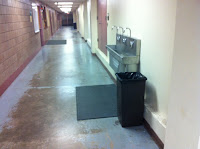Share and Voice
For weeks 8-14 we created posts that allowed us to be creative and post almost anything related to environmental health. I really enjoyed the share and voice and thought it was very educational. We could post things like blogs we came across, pictures that relate to the environment, websites, or pose a question. This was great because it gave me a chance to think on a deeper level and explore environmental topics/websites/blogs on my own. I also had a great time reading the posts of others and learning from my classmates.
Blogging
I didn't think there was anymore to learn, but I was wrong! I learned more about blogging and I know there is still more for me to explore on my own. One new thing that we did to our blogs was create an "about me" page. It was interesting to learn that there is kind of a guide to follow when writing the "about me" page in order to keep your audience interested and educated but not bored! This is a way for my followers to get to know me on a more personally level so that they can relate better to my posts. Another thing that I learned was about linky's. This is a way to share your post along with others posts all in the same place! It is like organizing posts into a one-stop-shop! Lastly, I learned about favicons and I got to design my own for my blog. This was something that I really enjoyed doing and for me it was a great learning experience. I never really knew what the symbol at the beginning of a web address was or what it was for. Now I know that it is a way to for websites to have their own symbol and use it as a marketing piece. If you think about popular websites like Facebook, their favicon is known worldwide!
 Advocacy Projects
Advocacy ProjectsFor the second half of the semester we started our advocacy projects. This was really a learning experience for me. We started by learning about advocacy, what it is, and using it in health education. I learned how to look for current bills, which ones have been passed and which ones haven't. For my project I looked at "Enhancing Liveability of All Americans Act of 2011 and really looked at air quality and how it can negatively affect our health if our air is constantly polluted. We also did some research on our political representatives which was a bit of a struggle at first but then I found who they are and who they represent. We did this so we could write a letter about the bill we chose and send it to the proper representative. I learned about how we can let our voice be heard and stand up for our rights!
My Junk Project
 We learned about junking throughout the semester and now we got to put our learning into action. Everyone in the class made a junk project and it was really amazing how people reuse different items. I have some very creative classmates and picked up some tips about taking an item and restoring it or making it into something new. What I did for my junk project was took broken hockey sticks and made a shoe rack with them. Our team breaks sticks pretty frequently and for the most part we just throw them in the garbage. I cut the sticks and assembled them into a shoe rack. It is currently being used at my house and we love it. There are 3 of us in the house from the hockey team and it is a way to decorate and store our shoes. My coach has been bugging me to make one for the rink so this is something I hope to do when we get back from Christmas break!
We learned about junking throughout the semester and now we got to put our learning into action. Everyone in the class made a junk project and it was really amazing how people reuse different items. I have some very creative classmates and picked up some tips about taking an item and restoring it or making it into something new. What I did for my junk project was took broken hockey sticks and made a shoe rack with them. Our team breaks sticks pretty frequently and for the most part we just throw them in the garbage. I cut the sticks and assembled them into a shoe rack. It is currently being used at my house and we love it. There are 3 of us in the house from the hockey team and it is a way to decorate and store our shoes. My coach has been bugging me to make one for the rink so this is something I hope to do when we get back from Christmas break!This class has truly taught me so many different things. I notice that in my every day living I am constantly thinking about environmental influences and how I can make a difference in preserving our earth. This class has made an impact on me and I have made changes in my life that I plan to continue even once this class is done.


















